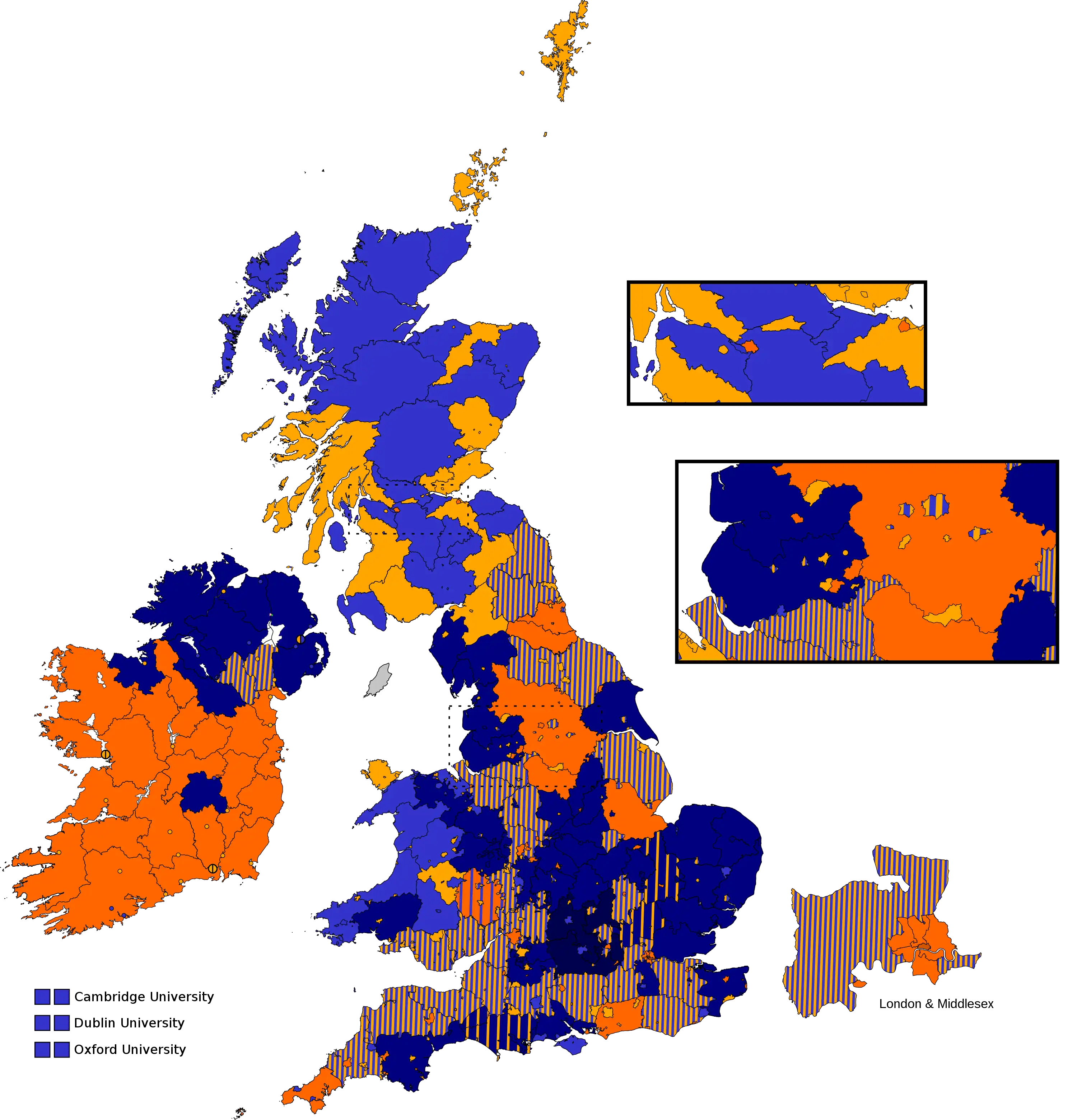53°06′32″N 2°30′14″W / 53.109°N 2.504°W
| South Cheshire | |
|---|---|
| Former county constituency for the House of Commons | |
| 1832–1868 | |
| Seats | 2 |
| Replaced by | Mid Cheshire West Cheshire |
South Cheshire was a parliamentary constituency in Cheshire, England represented in the House of Commons of the United Kingdom from 1832 to 1868. It was created upon the division of Cheshire in 1832. In 1868, it was abolished with North Cheshire to form parts of East Cheshire, Mid Cheshire, and West Cheshire.
History
South Cheshire, or the Southern Division of Cheshire, was created as a two-member constituency under the Representation of the People Act 1832 (Great Reform Act) as one of 2 divisions, along with North Cheshire, of the Parliamentary County of Cheshire. It comprised the Hundreds of Broxton, Eddisbury, Nantwich, Northwich and Wirral, and the City and County of the City of Chester.[1]
Under the Reform Act 1867,[2] Cheshire was further divided with the creation of Mid Cheshire, to which the Northwich Hundred was transferred. South Cheshire was renamed West Cheshire by the Boundaries Act 1868.[3]
Members of Parliament
| Election | First member | First party | Second member | Second Party | ||
|---|---|---|---|---|---|---|
| 1832 | George Wilbraham | Whig[4][5][6] | Richard Grosvenor | Whig[4] | ||
| 1835 | Sir Philip Grey Egerton, Bt | Conservative[4] | ||||
| 1841 | John Tollemache | Conservative[4] | ||||
| 1868 | Second Reform Act: constituency abolished | |||||
Elections
| Party | Candidate | Votes | % | ±% | |
|---|---|---|---|---|---|
| Conservative | Philip Grey Egerton | Unopposed | |||
| Conservative | John Tollemache | Unopposed | |||
| Registered electors | 6,826 | ||||
| Conservative hold | |||||
| Conservative hold | |||||
| Party | Candidate | Votes | % | ±% | |
|---|---|---|---|---|---|
| Conservative | Philip Grey Egerton | Unopposed | |||
| Conservative | John Tollemache | Unopposed | |||
| Registered electors | 6,949 | ||||
| Conservative hold | |||||
| Conservative hold | |||||
| Party | Candidate | Votes | % | ±% | |
|---|---|---|---|---|---|
| Conservative | Philip Grey Egerton | Unopposed | |||
| Conservative | John Tollemache | Unopposed | |||
| Registered electors | 7,068 | ||||
| Conservative hold | |||||
| Conservative hold | |||||
| Party | Candidate | Votes | % | ±% | |
|---|---|---|---|---|---|
| Conservative | Philip Grey Egerton | Unopposed | |||
| Conservative | John Tollemache | Unopposed | |||
| Registered electors | 8,117 | ||||
| Conservative hold | |||||
| Conservative hold | |||||
| Party | Candidate | Votes | % | ±% | |
|---|---|---|---|---|---|
| Conservative | Philip Grey Egerton | Unopposed | |||
| Conservative | John Tollemache | Unopposed | |||
| Registered electors | 8,735 | ||||
| Conservative hold | |||||
| Conservative hold | |||||
| Party | Candidate | Votes | % | ±% | |
|---|---|---|---|---|---|
| Conservative | Philip Grey Egerton | 3,110 | 36.5 | +0.9 | |
| Conservative | John Tollemache | 3,034 | 35.7 | +5.6 | |
| Whig | George Wilbraham | 2,365 | 27.8 | −6.5 | |
| Majority | 669 | 7.9 | +6.6 | ||
| Turnout | c. 5,437 | c. 71.1 | c. −9.5 | ||
| Registered electors | 7,645 | ||||
| Conservative hold | Swing | +2.1 | |||
| Conservative gain from Whig | Swing | +4.4 | |||
| Party | Candidate | Votes | % | ||
|---|---|---|---|---|---|
| Conservative | Philip Grey Egerton | 3,135 | 35.6 | ||
| Whig | George Wilbraham | 3,015 | 34.3 | ||
| Conservative | Edwin Corbett | 2,646 | 30.1 | ||
| Turnout | 5,712 | 80.6 | |||
| Registered electors | 7,084 | ||||
| Majority | 120 | 1.3 | |||
| Conservative hold | |||||
| Majority | 369 | 4.2 | |||
| Whig hold | |||||
| Party | Candidate | Votes | % | ||
|---|---|---|---|---|---|
| Conservative | Philip Grey Egerton | Unopposed | |||
| Whig | George Wilbraham | Unopposed | |||
| Registered electors | 6,343 | ||||
| Conservative gain from Whig | |||||
| Whig hold | |||||
| Party | Candidate | Votes | % | ||
|---|---|---|---|---|---|
| Whig | George Wilbraham | 2,661 | 36.1 | ||
| Whig | Richard Grosvenor | 2,406 | 32.7 | ||
| Tory | Philip Grey Egerton | 2,297 | 31.2 | ||
| Majority | 109 | 1.5 | |||
| Turnout | 4,756 | 92.7 | |||
| Registered electors | 5,130 | ||||
| Whig win (new seat) | |||||
| Whig win (new seat) | |||||
See also
References
- ↑ "The statutes of the United Kingdom of Great Britain and Ireland. 2 & 3 William IV. Cap. XLV: An Act to amend the Representation of the People in England and Wales". London: His Majesty's statute and law printers. 1832. pp. 154–206. Retrieved 27 July 2017.
- ↑ "Reform Act 1867" (PDF).
- ↑ "Boundaries Act 1868".
- 1 2 3 4 5 6 7 8 Stooks Smith, Henry. (1973) [1844-1850]. Craig, F. W. S. (ed.). The Parliaments of England (2nd ed.). Chichester: Parliamentary Research Services. p. 32. ISBN 0-900178-13-2.
- ↑ Churton, Edward (1838). The Assembled Commons or Parliamentary Biographer: 1838. p. 235. Retrieved 25 March 2019 – via Google Books.
- ↑ Mosse, Richard Bartholomew (1838). The Parliamentary Guide: a concise history of the Members of both Houses, etc. p. 230. Retrieved 25 March 2019 – via Google Books.
- 1 2 3 4 5 6 7 8 9 Craig, F. W. S., ed. (1977). British Parliamentary Election Results 1832-1885 (e-book) (1st ed.). London: Macmillan Press. ISBN 978-1-349-02349-3.
